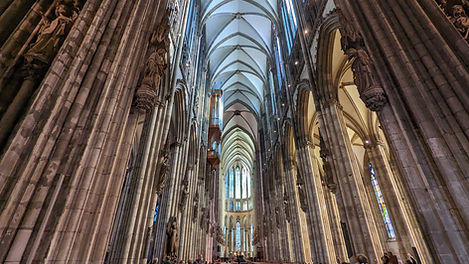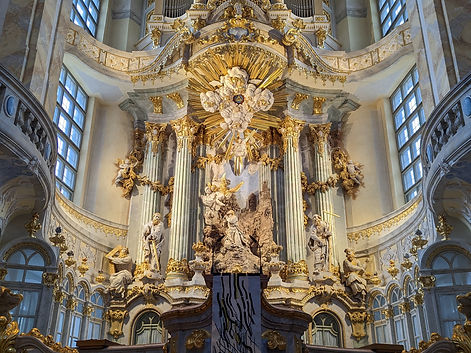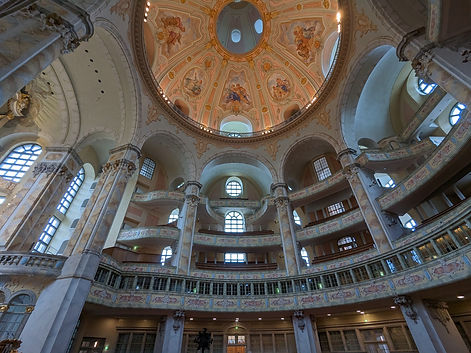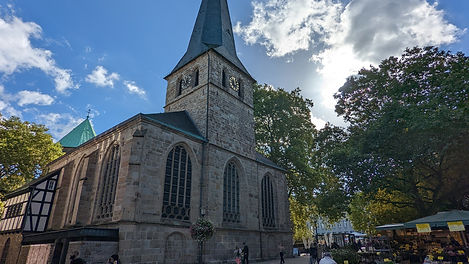
Germany
Europe's largest economy and most populous nation. Germany isn't noted for having the traditional "romance" of France, Italy, or Spain; but I keep getting drawn back in. I find the cities to be so varied and beautiful. You are certainly going to get very different experiences going to Berlin or Frankfurt or Cologne or Munich or Dresden. Plus, the countryside is gorgeous. I especially like visiting the Black Forest and Baden-Baden.
The stereotype of the German being more staid and stoic certainly holds a bit if validity, but don't mistake that for being unfriendly. I have always had incredibly kind experiences here.
If you are looking for art and history; you will find Germany to be every bit as good as the nations to the west like France and Italy.
If you are looking for quaint villages or rural castles and villas, Germany will exceed that of just about any country.
What you won't necessarily find here is the seaside like Barcelona in Spain, Marseilles in France, or Amalfi Coast in Italy. Germany has the Baltic Sea, but that is really reserved for just the warmest months.
Additionally, Germany won't really have what most lovers of cuisine are looking for. And, my favorite wines are not here.
But, all in all; I tell myself that I prefer France or Italy...yet I have have returned to Germany over and over again!

Old Town Frankfurt
Possibly my overall favorite city in Germany. First it is easy to get to by plane of train. Ans, it has a wonderful mix of old and new that makes it intriguing.
Cologne Cathedral
One of the most beautifully imposing cathedrals in the world. It is no wonder that 6 million people visit this each year.

Getting around in Germany
If you are going to journey around Germany, forget planes. You won't need them. The regional trains are numerous and convenient. DB (Deutsche Bahn) is the state owned, and largest, train operator; but there are also smaller companies offering services in local and regional areas. I understand there are over 400 rail companies in Germany. You will never be at a lack of trains.
But, if for some reason, trains are not your thing, there are also many bus companies throughout the country. I have used Flixbus in Germany and been quite happy with it. But, I don't have a lot of experience with busses as I vastly prefer the trains.
Even internationally, there are great train options when you consider the time and hassle at airports. Just a few examples; you can do Paris to Berlin in 9 hours or to Cologne in 4 hours. From Zurich, you can reach Frankfurt in 4 hours, Stuttgart in 3 hours, and Munich in 3.5 hours.
A couple of my favorite websites to research bus and train prices are Omio.com and thetrainline.com.
When it comes to local metro, I always use the apps that are available in most places. One app that is widely used through Switzerland, Germany and France is FAIRTIQ. My favorite thing about this app is that it calculates your ticket need and fare for you, and finds the best price. You just activate it at your start, and deactivate at the end. it does the rest. The downside is that I often seem to forget to deactivate. But, it is smart...it lets me know I need to end the trip. I don't know how it knows, but after a couple minutes walking away from the tram or bus, it pings me a reminder to end the trip.
In Berlin and Potsdam area, they use the BVG app. This is a little different as you need to choose the Zones you need (i.e. AB, BC, ABC). So, you need familiarity with the Zones. But, it is simple to use. Just purchase before boarding, and go. If you are visiting Berlin as a tourist, you will almost certainly use just AB. Zone C is for going more distant places, like Potsdam. As with all of the apps, transfers are allowed. And, the BVG offers a range of tickets. 20 minute short trip, 2 hour long trip, 24 hours, 7 day, monthly. It seems to have everything.
The Dusseldorf area, and the Rhine-Ruhr transport area, uses the Rheinbahn app. It is useful, but I didn't find it as user friendly as places like Dresden or Berlin.
Frankfurt uses the RMV app. I found this one easy, but you have to know the destination stop. Put in the start and stop of your trip, and buy the ticket. RMV offers a wide range of tickets, single journey, day, week, month, annual. Personally, I used single trips. But, the app will calculate for me if a daily trip would have been cheaper, and it will change the charges automatically to save me money. Kind of dummy proof.
All of these places will also have paper tickets you can purchase if you don't want to use the app. Machines are ubiquitous, but I find that smaller bus stops will not have a machine, so then you are stuck if you didn't buy a few tickets ahead, so that is a big reason I have switched to the apps.
Berlin
Capital city with 3.6 million residents, offering incredible art, and of course a great nightlife. As you can imagine, there is less remaining original architecture here than other cities in Europe. The damage from the war was extensive. So, much of it is rebuilt. But, retaining the original history.
Founded in the 13th century, the city has had a turbulent past; but today is known for its art and modern landmarks.
Though, Berlin only gets about 1/4 of the tourists as London or Paris, it is a wonderful place to visit.


Berlin Cathedral
Churches, as part of the Berlin City Palace, have been here since the 15th century. But, in the early 19th century, a neo classical church was built, and in 1893, that was torn down for the current grand church that was built to rival St Peter's in Rome and St Paul's in London. Heavily damaged during the war, restoration occurred between 1975 and 1993.
Today, you can visit, and also climb the 270 steps for a 360 degree view of the city.




Berlin TV Tower
The tower was built in east Germany between 1964 and 1969. Today, it is a popular destination for the view that can be as far as 80 kilometers. The observation deck is over 200 meters high, but you can visit the rotating restaurant above if you need a slightly higher view. However, the view comes at a cost. Ticket prices start at 28 euros for the observation deck or restaurant.


Charlottenberg Palace in Berlin
17th century Baroque palace on the west side of town ordered by Sophie Charlotte, wife of the Elector of Brandenburg. Built in Prussian Rococo: once a summer palace, Charlottenburg Palace is now the largest and most magnificent palace in Berlin.
If you are one who really enjoys palaces, Berlin and the surrounding Brandenburg State are the place for you. There are more than 30 palaces and gardens dating back to the Prussians and covering nearly 400 years of history. From your Berlin base, you can take trips to Sanssouci in Potsdam, and the castles of Rheinsberg, Caputh, Königs Wusterhausen, Oranienburg and Paretz. Among many others.




Brandenberg Gate
The restored 18th century sandstone gate originally built on the orders of Prussian king Frederick William II. It is the most recognizable symbol in Berlin, and marks a reminder of the days of separation. It was built between 1788 and 1791 and was strongly inspired by the Athenian Acropolis. Standing 85 feet tall, the chariot pulled by four horses on top was added 2 years later.


East Side Gallery
Once it was the Berlin Wall. Now it’s the longest open-air gallery in the world. Immediately after the wall came down in 1990; 118 artists from 21 countries began painting the East Side Gallery. Now, it is 1316 meters of art.
If you enjoy walking, it is just a half hour walk from Alexanderplatz, mostly along the Spree. Or, you can take the metro to the Ostbahnhof stop. Just a 10 minute ride. The, walk the last 5 minutes. It is well worth it. There is sure to be art here that will move you.




Berlin Art Museums
Gemäldegalerie, an art museum with 13th to 18th century masterpieces, including works by Rembrandt & Rubens.
Alte Nationalgalerie a collection of Romantic, Impressionist and early Modernist art in a colonnaded building.
Neue Nationalgalerie, European and American 20th century masterpieces.
The Bode, a riverside museum of sculpture and Byzantine art.
There are art museums here for everyone's taste. And, you can spend days just enjoying these museums.




Berlin History Museums
There is no shortage of amazing history museums in Berlin. You can visit the
Pergamon museum, built between 1910 and 1930 and housing art and archeology.
The Jewish History Museum, opened in 2001.
The Topography of Terror, opened in 1987 and focused on the story of Nazi persecution.
Also add the German Historical Museum, The Altes Museum with Roman and Greek artifacts, and the Berlin Story Bunker tracing 800 years of history.




Frankfurt
The history of Frankfurt dates back to the Celts in the 1st century CE and the Romans in the 2nd. The name Frankfurt may have originated around 500 CE meaning "Ford of the Franks". Charlemagne's biographer mentioned the city "Franconofurt" in the 8th century.
Frankfurt am Main was a free state from the 14th century until 1806 when Napoleon took over. After Napoleon fell, Frankfurt was free again until the Prussians took over in 1866.
Today, Frankfurt was a wonderful mix of new and old. From the 16th century cathedral to the 19th century opera house to the headquarters of the European Central Bank, Frankfurt highlights so many periods.
It may not be my favorite place to visit in Germany, but it would be close. Not just for the variety of things to see and do, but also for the ease of getting there and away. I have been here a few times now, and have also found it to be a pretty affordable place to visit.
If you are already in Europe, you may want to forget planes to get here. Frankfurt is only 4 hours by train from Berlin or Paris or Zurich, and 3 hours from Brussels.








Favorite things to see in Frankfurt
Römerberg
Any stay in Frankfurt should start right here. In the old town square, lined with timber buildings, and sitting next to the town hall, located here since 1405. While damaged during the war, this was rebuilt in the original style in 1986. Each timber building has its own name.
Frankfurt History Museum
Just to the south of Romerberg, this museum is quite large and extensive and gives a great history of the city. And, if you have children with you, right across is the Young Museum, built for kids.
Frankfurt Cathedral
16th century church soaring to a height of 311 feet. This has been the site of churches for centuries. Often destroyed and rebuilt,. The latest had to be largely rebuilt again in 1956.
Städel Museum
An impressive art museum form the middle age art to modern. You can even see the works online at sammlung.staedelmuseum.de
Munich
Germany's 3rd largest city and the EU's 11th largest. Located in the SE of Germany, in Bavaria. You will get the unique flavors and architecture of the area.
Though this is the 2nd most visited city in Germany, to be quite honest, it is not one that hit me as a place I would be anxious to return to. There is nothing wrong with it mind you. But, it is a business and industry center. Not a place known for art and culture as much as some other places in Germany like Berlin, Frankfurt or Dresden.
However, Munich is home to one of the grandest parties in the world, Oktoberfest. It attracts some 6 million visitors over its 18 days.
Getting to Munich is easy, as it is about a 4 hour train ride from Berlin or Frankfurt, with anywhere for 3-8 stops in between depending on which train you take. It is also a 4 hour train from Vienna.
Once you arrive, use the MVV network for transport. if you come from the airport, you can buy a airport/day ticket for 15.5 euro. After, single tickets are 3.90, and day tickets are 9.20.
When visiting, pick up the Munich City Pass for savings. It gives you free entrance to 45 attractions plus free travel on public transport. Prices range from 40 to 140 euros for 1-5 days, and also depending on how many transport zones you want. If you choose the option with all transport zones, it will include the airport.
Nymphenburg Palace
Located about 7 kilometers west of the city center. The summer residence built in the 17th century for the Bavarian Elector Ferdinand Maria. Sitting on 200 hectares, and a front width wider then Versailles, this palace is defintley magnificent.
Marienplatz
Marienplatz has been at the center of the city since Munich was founded by Henry the Lion in 1158. This square in the center of the city, with 2 town halls and St Peter's Church (Munich's oldest church), and the glockenspiel with 43 bells.
Hofbräuhaus München
According to legend, Wilhelm V, Duke of Bavaria, found the beer in Munich so bad that he commissioned his own state brewery. The Staatliches Hofbräuhaus was thus born, and in 1589, the beer hall opened. The brewery made beer for the royals for centuries and opened to the public in 1828.
English Garden
Huge 18th century park on the north side of town with over 45 miles of paths, and of course...a beer garden. After all, this is Bavaria. This is one of the largest city parks in the world at 375 hectares. Enjoy the view from Monopteros or watch the surfers on the Eisbach waves.




Baden-Baden and Black Forest
Baden is a resort town in the southwest famous for its spas with the world famous Black Forest just an hour away for hiking. You can certainly use Baden-Baden for its spas, after all it has been used this way since the Romans in the 3rd century at least. ("Baden" means swimming or bathing) and it is famous for the spas.
I have not visited a spa here, but, I use it for the proximity for hiking in the area. Just around the city itself there are wonderful hikes, and south of the city, they get even better.
For a change of pace, visit the modern art Museum Frieder Burda.








Cologne
Famous for its cathedral, but don't forget to take a walk along the Rhine and enjoy the old historic neighborhoods.
The city was first established by the Romans in the first century BCE as a fortification on the River Rhine. It was originally named Colonia Claudia Ara Agrippinensium, or Colonia for short. Over time, he city was conquered by The Franks in the 5th century and became independent by the 13th century.
The city thrived during the Middle Ages as a manufacturing hub and a member of the Hanseatic league.
Taken by France in 1794 and the Prussians in 1815, the city flourished further with the advent of the railroads.
Cologne Cathedral
Amazing! You will spend a lot of time in this cathedral admiring the architecture. Construction started in 1248 and it reaches 516 feet tall so this church is the focal point of the city and can be seen for miles around.
Fish market and Great St. Martin Church
from this market plaza on the river, you can admire the church sitting directly above. These colorful houses in front of the church are mostly rebuilt since they were destroyed in the war. Regardless, the combination of the river, the plaza, pink and yellow houses, and the church behind makes for a wonderful view.
You should also wander Cologne because there are so many treasures. Despite Cologne Cathedral getting all of the attention, there area dozen Romanesque churches in Cologne. it also has the oldest city hall in Germany and some scattered Roman era ruins.






Dresden
With a population of over 500,000; this is the 12th largest city in Germany. And, one of my favorite places in the country. It is large enough to offer a variety of activities, but small enough to be manageable. It has a very good representation in the arts, wonderfully reconstructed architecture, and plenty of open spaces and parks to visit.
Getting to Dresden is easy. From Berlin, you can take Flixbus for a 3 hour ride. But, the train from Berlin Central takes less than 2 hours. There are also buses and trains from Prague that take just over 2 hours. If you are coming from farther away, Frankfurt to Dresden is about 5 hours by train.




Frauenkirche Dresden
Baroque church reconsecrated in 2005 after being destroyed in World War II. The ruins of the church were left until German reunification, then reconstruction started in 1994.
Churches were on this site for 900 years. Originally a catholic church; it became Protestant after the Reformation. In 1727, the small church was torn down and replaced with a larger structure. The 67 meter high dome makes the church unique.




The Grand Garden of Dresden
Large, picturesque garden in the middle of Dresden, featuring baroque sculptures & a summer palace. Covering nearly 2 sq kms; it was originally established in 1676 on the orders of John George III, Elector of Saxony, and has been a public garden since 1814. Today, it also includes a zoo and botanical garden.
It is just a half hour walk form the center, or take the #1 or #2 bus east to the garden edge.




Dresdner Zwinger
The highlight of Dresden! Baroque buildings with a central garden, porcelain collection & exhibits on historic scientific instruments. Unfortunately, it was under renovation during my visit, but it was still beautiful.
Visit the adjacent gardens, stop at a cafe, or walk among the art of the masters...or do it all!




Dresden Art and Culture
An incredibly diverse offering from classical art to modern art...theatre and opera...specialty museums about porcelain, transportation, folk art, and the human body. Plus, many more. I feel like the must see museum is the Old Masters Picture Gallery, an impressive collection of European art from the 15th to 19th centuries.

Kunsthalle

Albertinum

Semperoper

Old Masters Picture Gallery
Dresden Castles
There are plenty of Grand Estates to visit. Some public, and some being used privately like hotels (like Albrechtsberg Palace or Lingnerschloss), but you can often still walk the gardens.
The most impressive and accessible is Pillnitz Castle and park, about a 20-30 minute drive east of the city, but easily reached by bus. Take the #4 or 12 to connect to the #63 that drops you right outside the gate.

Pillnitz Castle

Pillnitz Castle

Albrechtsberg Palace

Albrechtsberg Palace
Dusseldorf
Small old town on the east bank of the river, but Dusseldorf is known for being a fashion and financial center.
Tourism would be centered around the old town on the east side of the river.
Old Town Hall
Built between 1570 and 1573, this lovely building sits right on Marketplatz.
Rhine Promenade
walking along the river isn't the most scenic walk you will see in Europe. But, north of the Oberkasselerbrücke Bridge, you may see a lively outdoor marketplace or festival.
Museum Kunstpalast
Modern art museum on the north side of old town. Small museum with good temporary exhibits.




Essen
Known for being a coal mining and steel town that is an easy day trip from Cologne or Dusseldorf.
Despite having a population of over 500,000 people, it is not really a tourist town. There were a couple nice things to see though;
Essen Minster
The city grew up around the Essen Abbey in the 9th century, but the current church only dates from 1958. It is located in the center, right off BurgPlatz.
Welterbe Zollverein
Coal mining museum in the northeat part of town, on the site that was used since mid 19th century.
Museum Folkwang
Modern Art museum founded by Kart Ernst Osthaus




Potsdam
This capital of the state of Brandenburg is located about 20 miles southwest of Berlin. It is over 1000 years old and, today, is widely known for its palaces and the 20 lakes inside the city. Once home to the Prussian Kings, it was designed to embody the ideas if the Age of Enlightenment.
Getting to Potsdam is quite easy. From the Berlin Central Train station, you can take the RE1, RB23, or S7 trains which take 25-35 minutes to central Potsdam. From the train station, there are plenty of busses to take you onward. Use the 614 or 695 if you want to start the day at Sanssouci Palace.




Sanssouci Palace
Germany's largest World Heritage site. Built in the 1740's by Frederick the Great and enlarged in the 19th century by Frederick William IV; it was a summer residence for the Kings until the fall of the dynasty in 1918.
The park and gardens are particularly impressive. 3000 fruit trees, a 2.5 kilometer entry pathway highlight the park and gardens that encompass more than a square mile.




Palaces of Potsdam
How can a city of just 180,000 people have so many palaces??
along with the famous Sanssouci, there is;
New Palace is situated on the western side of the Sanssouci Park. Construction began in 1763, after the end of the Seven Years' War, under King Friedrich II and was completed in 1769.
Charlottenhof Palace is a former royal palace located southwest of Sanssouci Palace in Sanssouci Park. It is best known as the summer residence of Crown Prince Frederick William.
Orangery Palace is a Renaissance styled palace built between 1851 and 1864, with lookout tower and orangery wings still in use.
City Palace was built in the 17th century and expanded in the 18th century but destroyed by the Communist in 1960. it was rebuilt between 2006 and 2013. Currently used as a government center.
Belvedere Castle was commissioned by King Friedrich Wilhelm IV of Prussia and built between 1847 and 1863 as a viewing platform
Ceclilienhof was built from 1914 to 1917 in the layout of an English Tudor manor house. Cecilienhof was the last palace built by the House of Hohenzollern that ruled the Kingdom of Prussia and the German Empire until the end of WW 1.
Glienicke Palace is a villa from the 1820's set in Glienicker Park.
Babelsberg Palace was built between 1833 and 1849 and is located along Babel Park.


New Palace
Charlottenhof Palace

Orangery

Belvedere Castle

Glienicke Palace

City Palace

Cecilienhof

Babelsberg Palace
Brandenburg Gate in Potsdam
A neoclassical triumphal arch completed in 1770 & an iconic city landmark. Notably, this opened 20 years before its more famous version in Berlin.

